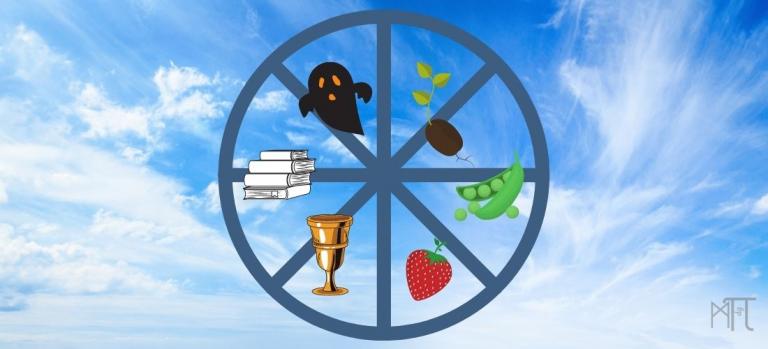
The Wheel of the Year is an established part of modern pagan practise. It’s something I ponder deeply when thinking about the upcoming festivals. For example I wrote a blog post last year about why the Autumn Equinox has never inspired me. But in general, it’s probably not something I think about too often.
I’m sometimes accused of wanting to reinvent the wheel for no good reason. I’ll admit it’s a habit I have. I look at things and want to pull at the stitching to find out why it was made that way and if it will hold.
Because it’s tradition, is not an answer I accept.
We hear a lot about the wheel of the year, often with criticism of certain authors shoehorning deities or practises into festivals.
However we hear a lot less about why it was conceived in this format.
Gardner first created Wicca with the four fire festivals – Imbolc, Beltane, Lammas, and Samhain. However the existence of the Solstices and Equinoxes wasn’t completely ignored. Later the four cross quarter festivals were added to the calendar.
This may have been to give covens more time to meet since many only got together during the sabbats.
Alexandrian tradition, however, had more of an emphasis on training so covens would meet far more often, some of them weekly.
Some witches choose to celebrate the moon cycles rather than the sabbats, or even to do both.
The coven I ran originally met for all the full moons and all the sabbats. I can tell you that involved a lot of cups to wash. It also meant it just wasn’t possible for every member to attend every event.
Eventually we shortened this to meeting every full moon and celebrating the nearest sabbat where possible on those days. I found this problematic because it meant we only worked at full moons. As a witch, I feel some magical workings need to be done at different moon phases.
More and more, my life dictates celebrating the moon phases or the set Wheel of the Year sabbats doesn’t work for me.
I sat back and thought, what’s stopping me doing it differently?
The only thing, it turned out, was that I had no other system which looked like it would suit me.
The Wheel of the Year was developed within the UK for the UK. That doesn’t mean no one else can use it, there’s no need for gatekeeping here. It just means the times and tides it references are specific to a small region of Europe.
Most antipodean witches have switched the festivals so they’re celebrating the ones which match their seasons rather than the calendar year.
I always wondered if there had been a better way. If rather than just picking it up and working it wholesale, other climates could adapt it to suit their seasons?
This year, with lockdown and a lot of soul searching, I decided I wasn’t going to work with the Wheel of Year anymore.
Instead, I’m going to trial working with a system which suits me better.
Instead of Gardner’s Wheel of the Year, I’ll be working more of a Gardener’s Wheel of the Year
For me, there are distinct times when things happen, and I want to be focused on certain types of mindset.
It’s less days and more seasons. Which means it works better to celebrate the beginning of a season and then use that as a springboard for focused working. Samhain for example has always kicked off a period of work with the dead. Lammas has always kicked off a month of enjoying the weather and relaxation.
The year is already chunked into pieces with the school terms. These originally followed the times when all hands were needed in the fields. You could argue the need for the school holidays to follow this format is also antiquated, but right now it’s easier to work with them than campaign for the whole country to change.
As a gardener, I’m also in touch with the seasons and what needs doing when.
I decided to work with the land and agricultural seasons more than I had been and base my new witch calendar on this.
I tried to create eight perfect seasons, but it just didn’t work.
And instead of making it match-y match-y for the sake of it, I decided to go with what worked.
So we start around now, at the February half term and continue as follows. I’ve used the word moon because I like it, but each time could easily be referred to as tides or phases.
Hungry Moon:
The point where the weather changes in February, usually around the February half term
Time for clearing and ploughing.
In witchcraft we can use this time for banishing, cleansing, tidying, planning, and organising
Seed Moon:
The Easter full moon is such a cultural pin point that I see no reason to not use this as my marker.
Time for planting, painting, and the first sustained outdoors work
This is an active time, taking the first steps to actioning plans, and energetic work
Strawberry Moon:
This is around Midsomar or the Whitsun Bank Holiday. It’s the point when the rains are becoming less regular and the ground is heating up. This is the first harvest – the peas and strawberries. It’s also time for more planting.
Time to take stock of projects, to start the next phase, and to be active, busy, and outside. A time of physical effort and exertion.
Singing Moon:
For me the summer is a time when I don’t do much witchcraft. The last week of July and the first week of August are often periods when I meet with lots of people and am sociable.
It’s a time of togetherness, of community, partying, and learning from each other.
Harvest Moon:
For me September has always been more about the holiday being over and it being time to get back to work. It’s also the time of the fruit and squash harvests. There is more planting to be done now the hottest weather of August is over.
The kinds of workings here are more introspective and intellectual. They involve research and writing and book learning.
Ancestor Moon:
Time to take stock of everything, to store things for winter and pick everything that needs taking out the ground before the first frosts.
For me this time of year will always be about the dead and other realms. It’s a time for communing with spirits, ancestors, and deities.
Yule Moon:
Christmas and New Year always mark the point for me when the weather changes to cold. Apart from the brevity of Christmas, it’s a time when I feel least energetic and motivated.
Instead of fighting the urge to hibernate I’m going to spend this time eating the stored food before it goes off, sleeping, and resting.
This does mean, in general, you’re likely to see silence from me during the Patheos Pagan tradition of writing a blog post for the festival we’re entering.
There will be plenty of festivals I don’t celebrate.
You will instead see posts detailing what I’m doing whilst I follow my own seasons. Which if nothing else will be unique! Hopefully they’ll inspire you to rethink your own celebrations too.

















